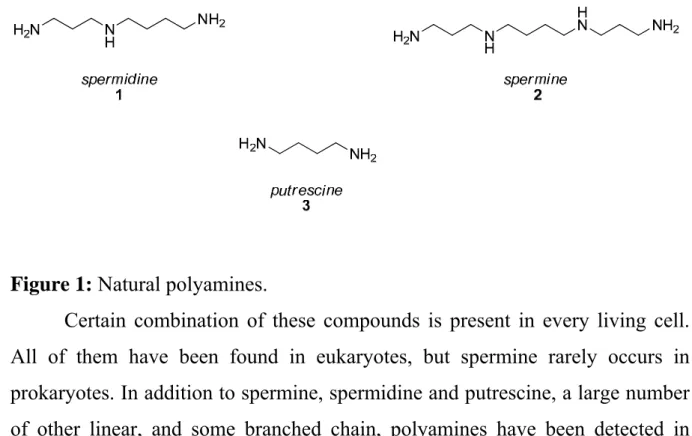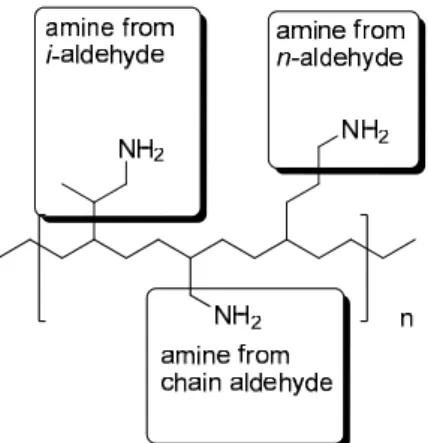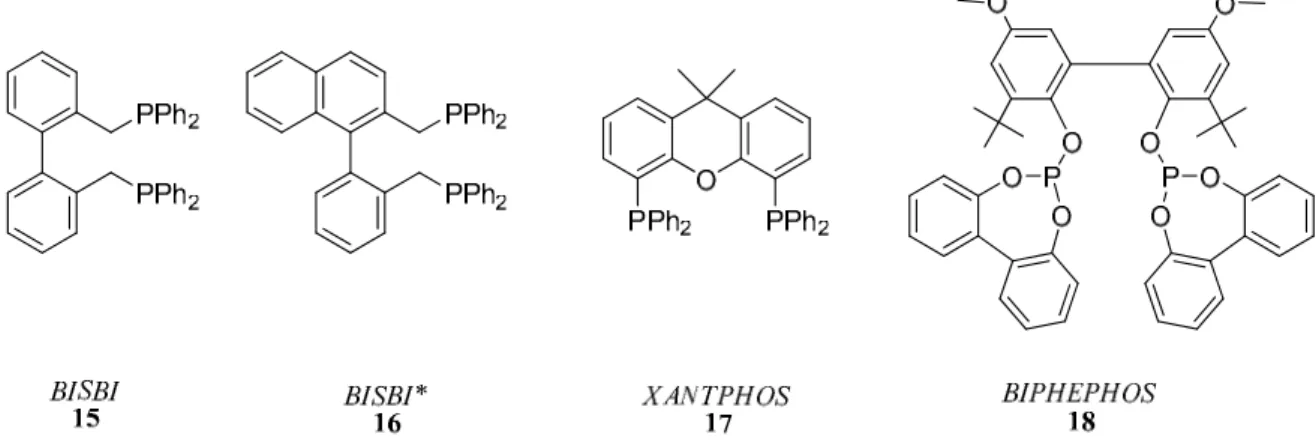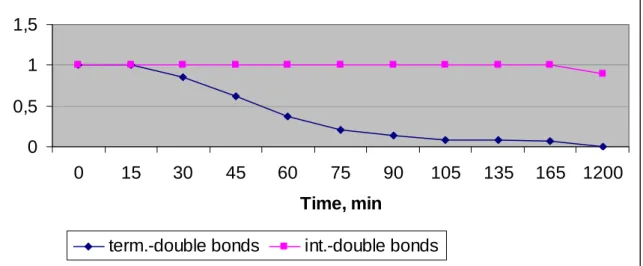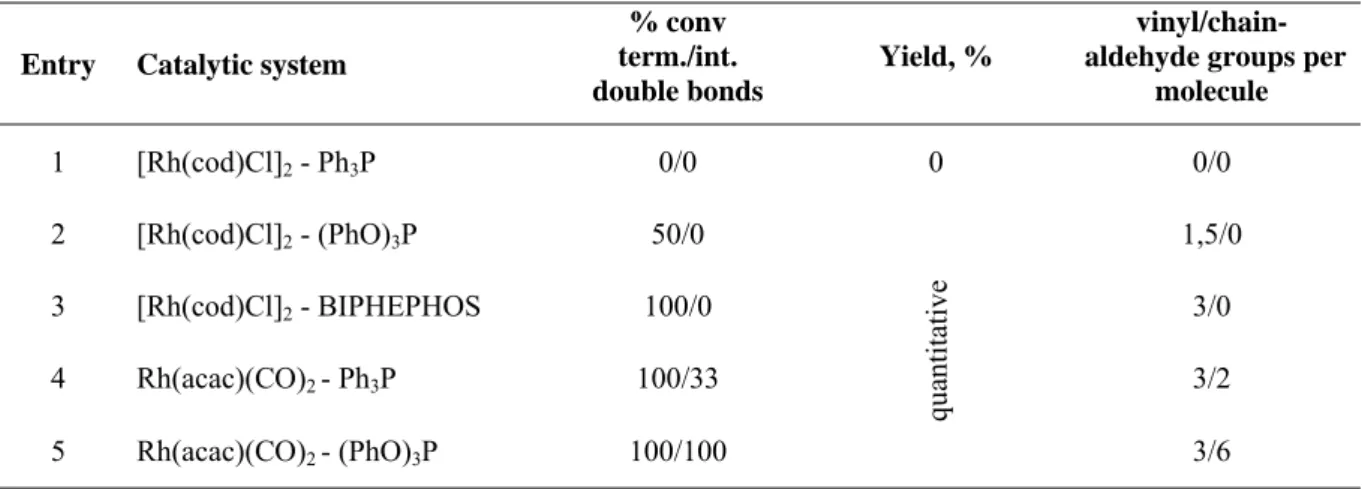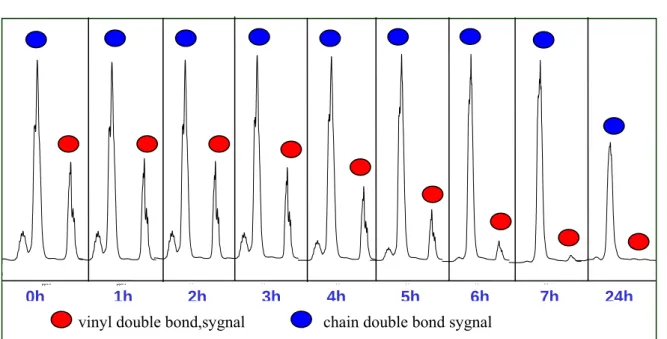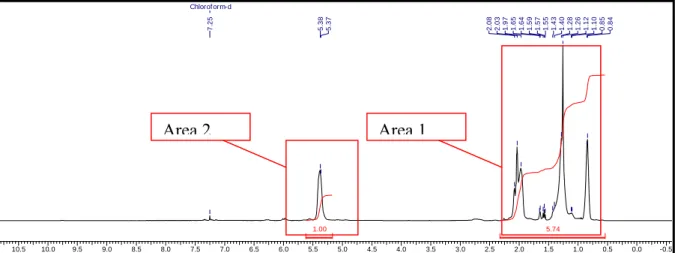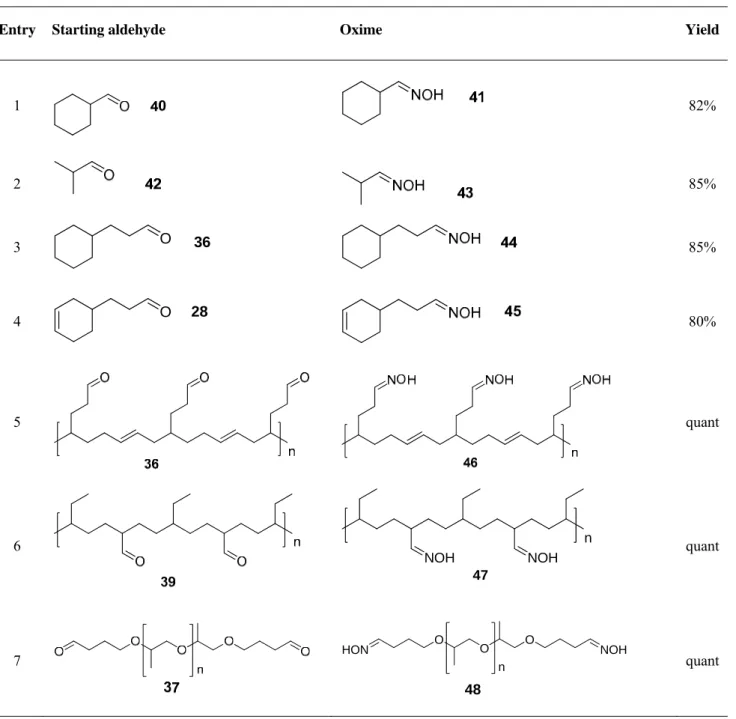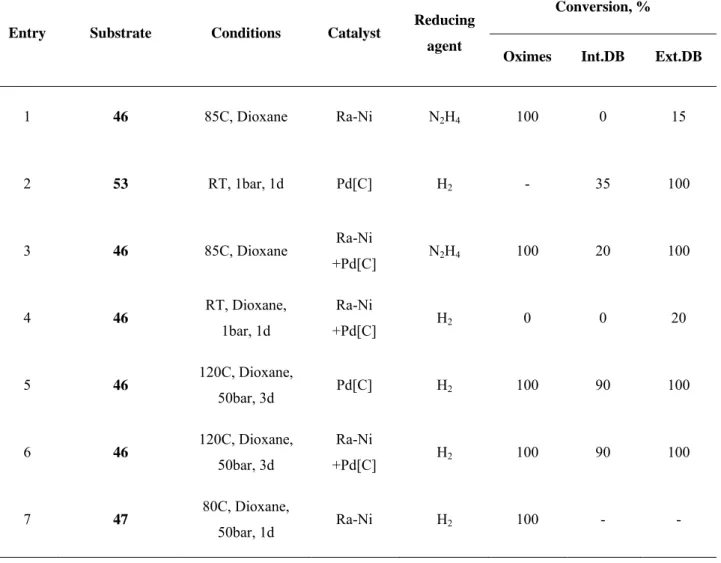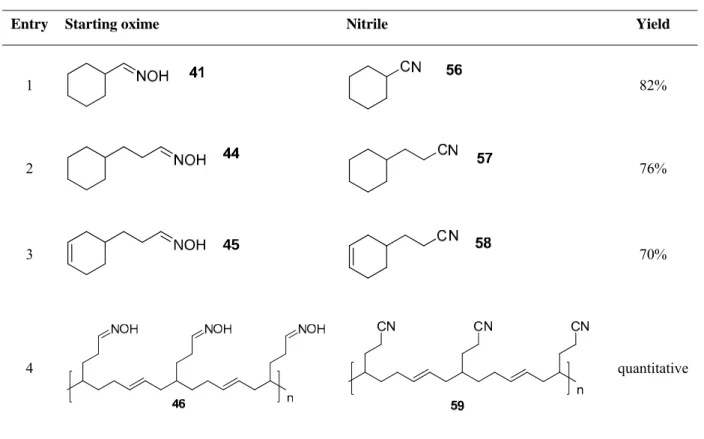POLYOLEFINS
Dissertation Zur
Erlangung des akademischen Grades eines Doktors der Naturwissenschaften
(Dr. rer. nat.)
des Fachbereichs Chemie der Universität Dortmund vorgelegt von
Yevgen Berezhanskyy aus Dnepropetrovsk (Ukraine)
Dortmund, 2008
1. Gutachter: Prof.Dr. Peter Eilbracht 2. Gutachter: Prof.Dr. Norbert Krause Tag der mündlichen Prüfung: 6.03.2009
This work was done in period from April 2005 till April 2008 at the faculty of organic chemistry, University Dortmund under the supervision of Prof.Dr.Peter Eilbracht.
My sincere appreciation goes to my supervisor Prof.Dr.Peter Eilbracht, for the interesting topic, valuable discussions and support. Working under his supervision I have received support and encouragement in that way that allowed me not only to finish and complete this thesis but also received support for future scientific work.
I would like to extend my thanks to the official referees Prof.Dr. Peter Eilbracht and Prof.Dr.Norbert Krause for the review, criticism and advices during the preparation of this work. I would also like to thank other member of my PhD commitie Dr.Alexandra Hölemann for reading and providing comments on my thesis.
I appreciate our collaboration partners Prof.Dr.W.Leitner, Dipl.Chem.T.Koch, PD Dr.T.Müller, Dipl.Chem.A.Suppan, Dr.S.Nosov, Prof.Dr.Erker, Dr.J.Ugolotti, Dr.C.Gürtler, Dr.A.M.Schmidt, for supply with materials beside further useful discussions and helpful practical supports.
Also I would like to thank former and present members of P.Eilbracht group for their help and support: Dr.K.-S.Müller, Dr.S.Chercheja, Dr.M.Beigi, Dr.S.Ricken, Dr.A.Subhani, Dr.B.Bondzic, M.Gatys, J.Liebich, Dr.I. Kownacki, Z. Krausova (Alexandrová), K. Tuz (Kot), N. Mészáros, T. Rothenbücher, Dr.
A.Kovalchuk, L.Okoro, A.Farwick, Dr.N.Susnjar, Dr.V.K.Srivastava, Dr.S.Nave, K.Weber, J.Krimmel, B.Appel, Y.Ali, K.Dogan, T.Dyczczak, R.Lawniczek, Dr.S.Nadakudity, J.Schmidt, U. Vogel, A. Marek, R. Sivek and R.
Keder.
I want to thank the members of NMR, MS laboratories and Laboratory of Elemental Analysis.
My special thanks go to my parents Olga and Anatoly Berezhanskyy and my sister Nataly Rybak for continuous support.
Index of abbreviations and symbols Ac acetyl
acac acetylacetonato bp boiling point
br broad
Bu butyl
d doublet (NMR) DB double bond
dd doublet of doublets (NMR)
ddd doublet of a doublet of doublets (NMR) dq doublet of quartets (NMR)
dt doublet of triplets (NMR)
FAB fast-atom bombardment mass spectroscopy GC gas chromatography
Hz Hertz
i- iso
J NMR coupling constant m multiplet (NMR)
M+ molecular peak mp melting point n- normal
NMR nuclear magnetic resonance spectroscopy p total pressure
PB polybutadiene
PBAl polybutadiene aldehyde, aldehyde from polybutadiene PBAm polybutadiene amine
PBOx polybutadiene oxime PBNi polybutadiene nitrile PBR polybutadiene reduced
PBRAl polybutadiene reduced aldehyde, aldehyde from reduced polybutadiene
PBRAm polybutadiene reduced amine, amine from reduced polybutadiene PBROx polybutadiene reduced oxime, oxime from reduced polybutadiene PBRNo nitro polybutadiene
Ph phenyl
ppm parts per million (NMR) Pr propyl
q quartet (NMR) rt room temperature s singlet (NMR) t time, triplet (NMR) THF tetrahydrofuran Ts tosyl
1. INTRODUCTION ... 7
1.1.POLYMERS ... 7
1.2.POLYAMINES ... 8
2. THEORETICAL PART ... 14
2.1.HYDROFORMYLATION STUDIES ... 14
2.1.1. Hydroformylation of polybutadienes ... 19
2.2.PREHYDROGENATION OF POLYBUTADIENES ... 25
2.3.SYNTHESIS OF AMINES VIA OXIME FORMATION AND REDUCTION ... 31
2.3.1. Synthesis of oximes ... 32
2.3.2. One pot hydroformylation-oxime formation ... 33
2.3.3. Reduction of oximes ... 34
2.4.SYNTHESIS OF AMINES VIA NITRILES ... 39
2.4.1. Synthesis of nitriles from oximes ... 39
2.4.2. Knoevenagel condensation ... 40
2.4.3. Kondensation of malonic acid nitriles with aldehydes ... 42
2.4.4. One step Hydroformylation – Knoevenagel condensation ... 44
2.4.5. Decarboxylation reactions ... 45
2.4.6. Reduction of nitriles ... 46
2.5.SYNTHESIS OF AMINES VIA NITRO COMPOUNDS ... 47
2.5.1. Preparation of nitroalkenes ... 47
2.5.2. Condensation with nitromethane ... 48
2.5.3. Condensation with nitroethane ... 50
2.5.4. Tandem hydroformylation – nitroaldol reaction ... 51
2.5.5. Reduction of nitroalkenes ... 53
2.6.SYNTHESIS OF N-SUBSTITUTED CARBAMATES ... 56
2.6.1. Carbamination of aldehydes ... 56
2.6.2. One pot hydroformylation – carbamidation of olefins ... 59
2.6.3. Alkylation of carbamates with alcohols ... 60
3. ANALYTICAL PART ... 62
4. SUMMARY ... 67
4. ZUSAMMENFASSUNG ... 74
5. EXPERIMENTAL PART ... 81
6. REFERENCES ... 125
1. Introduction
1.1. Polymers
A polymer, derived from the Greek πολυ, poly, "many"; and µέρος, meros, "part", is a substance which consists of molecules with large molecular weight composed of repeating structural units (monomers).
Polymers have been with us from the beginning of time; they form the very basis (building blocks) of life. Animals, plants — all classes of living organisms — are composed of polymers. However, the concept of polymeric chain as we understand it today had to wait for the work of Staudinger (Nobel Prize laureate in 1953) before being fully accepted. The variety of synthetic polymers discovered by Staudinger is impressive, and a number of today’s polymeric substances were prepared for the first time by this outstanding scientist. His work soon attracted the keen interest and attention of the chemical industry1,2.
Due to the high molar masses, polymers show particular properties not observed for any other class of materials. The mutual entanglement of the chain molecules, for example, results in excellent mechanical properties when applied in films or fibers. Thermoplasticity allows for convenient processing of polymers into manifold commodity products via extrusion or injection molding, and orientation of the chain molecules in fibers and textiles leads to extraordinary tensile strengths3.
It is no surprise that the name of several Nobel laureates appear on the list of scientists who have contributed the most to polymer science. In addition to Staudinger, these include Ziegler, Natta, Flory, de Gennes, McDiarmid, Shirakawa, Heeger, and, recently, Chauvin, Grubbs, and Schrock. There are also many scientists whose names are known only to experts and whose contributions were instrumental in the development of the polymer field.
In recent years, as a result of better understanding of polymer structure–property relationships, introduction of new polymerization techniques, and availability of new and low-cost monomers, the concept of a truly tailor-made polymer has become a reality. Today, it is possible to create polymers from different elements with almost any quality desired in an end product. Some polymers are similar to existing conventional materials but with greater economic values, some represent significant improvements over existing materials, and some can only be described as unique materials with characteristics unlike any previously known to man4.
For practical reasons it is useful to classify polymeric materials according to where and how they are employed. A common subdivision is that into structural polymers and functional polymers. Structural polymers are characterized by their good mechanical, thermal, and chemical properties. They are primarily used as construction materials in addition to metals, ceramics, or wood in applications like plastics, fibers, films, elastomers, foams, paints, and adhesives. Functional polymers, in contrast, have completely different property profiles, for example, special electrical, optical, or biological properties. They can assume specific chemical or physical functions in devices for microelectronic, biomedical applications, analytics, synthesis, cosmetics, or hygiene5.
1.2. Polyamines
Polyamines appeared to be constituents of many compounds found in plants and insects. Polyamines are, in general, linear aliphatic molecules of, in biological terms, small molecular mass. The structures of three most commonly occurring natural polyamines spermidine (1), spermine (2) and putrescine (3) are shown in Figure 1.
Figure 1: Natural polyamines.
Certain combination of these compounds is present in every living cell.
All of them have been found in eukaryotes, but spermine rarely occurs in prokaryotes. In addition to spermine, spermidine and putrescine, a large number of other linear, and some branched chain, polyamines have been detected in mammalian tissues and excreta, or in plants, bacteria, and microorganisms6,7,8,9.
It is known that polyamines are synthesized in cells via highly-regulated pathways, but in the meantime their actual function is not entirely clear. As cations, they bind to DNA, and, in structure, they represent compounds with cations that are found at regularly-spaced intervals. If cellular polyamine synthesis is inhibited, cell growth is stopped or severely retarded. The provision of exogenous polyamines restores the growth of these cells. Most eukaryotic cells have a polyamine transporter system on their cell membrane that facilitates the internalization of exogenous polyamines. This system is highly active in rapidly proliferating cells and is the target of some chemotherapeutics currently under development10.
The basic chemistry of amino resins was established in 190811, but the first commercial product was patented only in 1925 in England12. It was based on a resin made from an equimolar mixture of urea and thiourea and reinforced with purified cellulose fiber. The new product was hard and not easily stained and was available in light, translucent colors; furthermore, it had no
objectionable phenolic odor. The use of thiourea improved gloss and water resistance, but stained the steel molds. As amino resin technology progressed the amount of thiourea in the formulation could be reduced and finally eliminated altogether.
In the early 1920s, experiments with urea–formaldehyde resins in Germany13 and Austria14 led to the discovery that these resins might be cast into clear transparent sheets, and it was proposed that this new synthetic material might serve as an organic glass.
In our days synthesis of polyamines is achieved via substitution reactions of primary or secondary amides15 and amines16, reductive amination of aldehydes and ketones17. Moreover polyamines can be prepared by reduction of amides, nitriles18 or azides. It has to be mentioned that selective amine formation requires use of protective groups.
Many functional polyamines are synthesized via direct polymerization of amine containing monomers. Some of the polyamine building blocks are depicted in Figure.
Figure 2: Polyamine monomers.
Polymers, like polyvinylamine can be synthesized in numerous ways19, 20,
21. But it was found that only use of the precursors such as tert-butyl N- vinylcarbamate22, 23 and N-vinylformamide24, 25 result in a polyvinylamine with no defect structure and reasonable molecular weights.
Scheme 1: Synthesis of polyvinylamine from vinylformamide.
The present work deals with the synthesis of polyamines from polybutadiene oligomer.
Polybutadiene accounts for 24.5 % of the world's production of synthetic rubber. Being a second largest volume synthetic rubber, next to styrene- butadiene rubber, with consumption around 2,000,000 metric tons per year, polybutadienes (or butadiene rubber, BR) find its use in many applications.26
Polybutadiene is a homopolymer (only one monomer) of 1,3 butadiene (7), a monomer containing four carbon atoms, and six hydrogen atoms (C4H6).
The four carbon atoms are in a straight chain containing two “double bonds” as follows (Figure 3).
Figure 3: Structure of 1,3-butadiene.
Most polybutadienes (8) are made by a solution process, using either a transition metal complex or an alkyl metal, such as butyllithium, as catalyst.
Compare to the alkyllithium, transition metal catalysts perform polymerization in a different way. The transition metal catalysts produce stereoregular polybutadienes while alkyllithium catalysts produce a polymer with about 40%
cis, 50% trans and 10% vinyl.
Figure 4: Schematic structure of polybutadiene
As the double bonds in polybutadiene are not active enough to be transformed to the amine groups directly we used the hydroformylation reaction, to convert double bonds to the more reactive carbonyl groups, with a further aim of amine function creation. Polybutadiene can undergo hydroformylation giving two different kind of aldehydes: normal and branched from vinyl groups and aldehydes formend under hydroformylation of the chain double bonds. Thus the final product formed, can contain primary polyamines with different side chain structure as shown in figure (Figure 5).
Figure 5: Schematic structure of desired polyamine
The most convenient way to create the desired primary amines might be reductive amination of carbonyl compounds27 or hydroaminomethylation of olefins28 with ammonia as a cheap reagent. (Scheme 2).
Scheme 2:Hydroformylation – reductive amination and hydroaminomethyletion pathways.
Unfortunately, previously reported results29 on reductive amination and hydroaminomethylation showed that any interaction of polymeric aldehydes with ammonia or ammonia salts leads to formation of insoluble solids. The results of reactions did not depend on the structure of polymers used or the amount of aldehyde groups in the molecule as well on the physical state of ammonia (liquid, salt or solution in methanol).
In this light, development of efficient synthetic routes for the synthesis of polyamines from polyolefins is of high interest. Moreover a high selectivity towards primary amine formation is required. There are several methods and pathways available in order to achieve above mentioned goals, such as
• reduction of aldehydes to alcohols and aminolysis
• cyanohydrine formation and reduction
• Wacker oxidation and reductive amination
• acrylonitrile reaction with vinyl group and reduction
• cross metathesis with acrylonitrile and reduction
but in the present work we will focus on the following methods:
• hydroformylation, oxime formation and reduction
• hydroformylation, nitroaldol reaction and reduction
• hydroformylation, nitrile formation and reduction
2. Theoretical Part
2.1. Hydroformylation studies
Hydroformylation is the addition of a formyl group (CHO) and a hydrogen atom to a carbon-carbon double bond of an alkene to produce linear and branched aldehydes having one more carbon atom than the original compound (Scheme 3).
Scheme 3: Hydroformylation reaction
Hydroformylation “Oxo synthesis” was discovered by Otto Roelen in 1938 during an investigation of the origin of oxygenated products occurring in cobalt catalyzed Fischer -Tropsch reactions. Roelen's observation that ethylene, H2 and CO were converted into propanal, and at higher pressures, diethyl ketone, marked the beginning of hydroformylation30.
Nowadays, hydroformylation is one of the largest homogeneously transition metal catalyzed industrial processes. Most of the seven million tons of aldehydes produced annually by this process are reduced to alcohols or oxidized to carboxylic acids. Esterification of the alcohols produces plasticizers — the largest end-use. Detergents and surfactants make up the next largest category, followed by solvents, lubricants, and chemical intermediates. Asymmetric hydroformylation of several functionalised alkenes opens the way to production of chiral aldehydes, which can be used as a starting material for the synthesis of agro- and pharmaceutical chemicals.
The most important hydroformylation process on industrial scale, propene (9) hydroformylation, provides about 75% of all oxo chemicals consumed in the world31.
Scheme 4: Hydroformylation of propene
Traditionally, the aim of this process has been to produce regioselectively the linear aldehyde, n-butanal (10). The n-butanal is converted to dioctyl phthalate, a plasticizer utilized in a wide range of PVC applications via reactions with 2-ethylhexanol. Recently, interest has focused on selective formation of the branched form, isobutanal (11), which now represents 9% of total production capacity and finds use in the production of polyols, such as neopentyl glycols.
Roelen's original research into hydroformylation involved the use of cobalt salts which, under H2/CO pressure, produced HCo(CO)4 as the active catalyst precursor. The reaction conditions for HCo(CO)4 hydroformylation are largely governed by the thermal instability of HCo(CO)4, which produces metallic cobalt if the CO partial pressure is not kept high enough. As the reaction temperature is increased, the CO partial pressure, required to maintain the stability of HCo(CO)4, increases in a logarithmic fashion. Thus, the temperatures needed for reasonable reaction rates (110-180°C) require rather high CO partial, and hence, total H2/CO pressures of 200-300 bar
.
One advantage of the HCo(CO)4 technology is that catalyst separation and recycling is well established. BASF oxidizes HCo(CO)4 with O2 to form water soluble Co2+ salts that are extracted from the product stream. These Co2+ salts are recycled and reduced under H2/CO to regenerate HCo(CO)4. Exxon uses aqueous NaOH to deprotonate HCo(CO)4 after catalysis to make Na[Co(CO)4],which is extracted into an aqueous stream. The active HCo(CO)4 catalyst is regenerated with H2SO4 and H2/CO.
The only variation on HCo(CO)4 hydroformylation catalysis involved research at Shell by Slaugh and Mullineaux in which the addition of trialkylphosphine ligands caused a change in the rate and regioselectivity32. The electronic effect of substituting an electron donating alkylated phosphine for one of the carbonyl ligands to produce HCo(CO)3(PR3), results in stronger Co-CO bonding. This causes a dramatic decrease in the CO partial pressures required to stabilize the catalyst and prevent formation of metalic cobalt. Instead of 200- 300 bars of H2/CO pressure needed for HCo(CO)4, the monophosphine substituted HCo(CO)3(PR3) only needed 50-100 bars of pressure, and could be run at higher temperatures without any decomposition of the catalyst to metalic cobalt.
Cobalt catalysts completely dominated industrial hydroformylation until the early 1970s when rhodium catalysts were commercialized. The first investigations on rhodium-catalyzed hydroformylation were carried out at the end of 1950s, about 20 years after the discovery of the cobalt-catalyzed “oxo”
reaction by Roelen. Initially, simple catalyst precursors such as RhCl3 and Rh/Al2O3, were employed. Even at the beginning it was clear that the rhodium- based catalysts were much more active than the cobalt based ones.
The following unmodified catalyst precursors are those most frequently employed in hydroformylation of vinyl and vinylidenic substrates: Rh4(CO)12, [Rh(CO)2(Cl)]2, [Rh(CO)2(acac)]2, [Rh(cod)(OAc)]233, 34, 35, 36. As reported by several authors37,10, Rh4(CO)12 generates, under hydroformylation conditions, a rhodium-carbonyl hydride [HRh(CO)3], which constitutes the catalytic active species of the reaction. The rhodium hydride tricarbonyl species easily coordinates the vinyl substrate, generating the π-complex, which is converted to the alkyl-rhodium intermediates through insertion of the alkene into Rh-H bond.
Migratory insertion of the alkyl moiety on to a CO molecule coordinated to the
metal center provides the acyl-rhodium species, which, at the end of the catalytic cycle, interacts with hydrogen via an oxidative addition, giving rise to aldehydic products and regenerating the rhodium-hydride species (Scheme 5).
Scheme 5: Generally accepted mechanism for the rhodium-catalyzed hydroformylation38.
A similar process probably occurs with the other catalytic precursors.
This unmodified Rh catalytic precursor is still the subject of detailed investigations.
Rhodium-catalyzed hydroformylation using catalysts modified with alkylphosphines and arylphosphines was reported by Wilkinson’s group8. Phosphine ligand variation strongly affected the rate and selectivity under the circumstances used. Pruett found that phosphites can also be used, and the type of phosphite had a profound effect on rates and selectivities39. Monodentate ligands, be they phosphines or phosphites are very versatile ligands for rhodium
catalyzed hydroformylation, but they can not provide high regioselectivities of the process. So the regioselectivity of 1-alkene hydroformylation based on triphenylphosphine (12) modified catalysts varies from 70 to 92% for the linear aldehyde, depending on concentration of PPh3 and CO pressure, and about 70%
for bulky monophosphite (14) based catalysts.
Figure 6: Monodentate phosphine and phosphite ligands.
Union Carbide, Eastman Chemical, and Prof. Piet van Leeuwen have independently developed a new generation of chelating bisphosphine and bisphoshite rhodium catalysts that show remarkably high product regioselectivities and good to high activities. Two of the best Eastman bisphosphine ligands, developed by Devon, Phillips, Puckette and coworkers are called BISBI40 (15) and BISBI* (16). Prof. Piet van Leeuwen at the University of Amsterdam developed the XANTPHOS41,42 (17) family of ligands. The Union Carbide (now Dow) ligand system, BIPHEPHOS43 (18), developed by Billig and co-workers is a bulky bisphosphite ligand.
Figure 7: BISBI, BISBI*, XANTPHOS and BIPHEPHOS bidentate ligands.
2.1.1. Hydroformylation of polybutadienes
For our hydroformylation experiments we used polybutadiene with molecular weight of 1000g/mol, terminal double bond content 33%. To simplify naming of polymer compounds we invented following abbreviations:
PB-33-1 – where PB means PolyButadiene, 33 – content of terminal double bonds, 1 – molecular weight in Daltons.
Also we used allylated polyether, which was synthesized by allylating polypropyleneoxide diol (19) (DESMOPHENE -2054). Methods described in the literature14 did not prove to be useful, allylation was achieved by treating (19) with sodium hydride under solventless conditions at 100°C, until the reaction mixture became too viscous to be stirred, followed by addition of anhydrous THF and allylbromide to give an allylated product (20).
Scheme 6: Allylation of dihydroxy polypropyleneoxide.
Our first experiments on hydroformylation of the polybutadienes at 40 bar carbon monoxide and 40 bar hydrogen pressure, using [Rh(cod)Cl]2-Ph3P complex as a catalyst precursor, gave full conversion of all double bonds after 1 day of reaction to give a polyaldehyde (22)(Scheme 7).
Scheme 7: Hydroformylation of polybutadiene.
For a more detailed study it was necessary to differentiate signals of linear and branched aldehydes derived from the external double bonds, aldehyde signals from internal double bonds and calculate the amount of aldehyde groups in the final product.
To solve this problem and to understand the hydroformylation of the compounds containing both terminal and internal double bonds we decided to use small molecules, which could be used as the model compounds for our process.
For this reason we have chosen vinylcyclohexane (23) (containing only a terminal double bond), cyclohexene (24) and cyclopentene (27) (containing an internal double bond), 4-vinyl-1-cyclohexene (26) (containing both terminal and internal double bonds) and methylcyclohexene (25) (for investigation of double bond migration) (Figure 8).
Figure 8: Model compounds
During hydroformylation of 26 at 40 bar CO, 40 bar H2 and 120°C we could expect products from terminal double bond hydroformylation (n-, i- aldehydes, 29, 30) and aldehydes from possible double bond migration in cyclohexene ring 31, 32 (Scheme 8):
O O
O
O
O O
+ + +
CO / H2 [Rh(cod)Cl]2,Ph3P
26 28 29 30 31
Scheme 8: Hydroformylation of 4-vinyl-1-cyclohexene.
Monitoring this reaction by 1H-NMR (Figure 9), we observed that vinyl double bonds are hydroformylated much faster than internal ones. From the graphics we can see that terminal double bonds (Figure 9, a) are completely hydroformylated after 135 minutes to give n- and i- aldehyde isomers with constant ratio 4:1 (n/i) during the reaction (Figure 9, b), while internal double bonds are at the same range and even after 20 hours we had only a small amount of aldehyde derived from the internal double bonds.
Figure 9: 4-vinyl-1-cyclohexene hydroformylation time-concentration profiles.
Also we performed hydroformylation of methylcyclohexene (25) to find out if there is a double bond migration in the cyclohexene ring (Scheme 9).
0 0,5 1 1,5
0 15 30 45 60 75 90 105 135 165 1200
Time, min
term.-double bonds int.-double bonds
0 0,2 0,4 0,6 0,8
0 15 30 45 60 75 90 105 135 165
Time, min n-aldehyde iso-aldehyde
Scheme 9: Hydroformylation of 4-methylcyclohexene
On the GC chromatogram we observed only 2 product peaks which can be assigned to the products of hydroformylation in positions 3 and 4 of the ring 33, 34.
From these results we could make a conclusion that terminal double bonds are much more reactive during hydroformylation than the internal ones, and we have 2 isomers from terminal double bond and only 2 isomers from internal double bond hydroformylation.
But, transferring these conditions to the hydroformylation of the polybutadienes 21, we found out that after 2 hours almost all the double bonds (terminal and internal) are converted to give n- and iso- aldehydes from terminal double bonds and aldehydes from internal double bonds to give unsaturated polyaldehyde 35.
n
n
O O O
O 40 bar CO, 40 bar H2
[Rh(cod)Cl]2-Ph3P 120oC, 2 h
21 34
Scheme 10: Hydroformylation of polybutadiene.
Here it is worth noting that one of the requirements in functionalization of the polybutadiene is that the number of functional groups in the molecule must be from 3 to 6 and running the reaction at harsh conditions gives us much higher conversion than we need. Due to this reason we should find a method which allows us to moderate the process.
The first idea was to hydroformylate the required amount of terminal double bonds, convert aldehyde groups to nitrogen containing groups and, during reduction to primary amine, reduce the rest of the double bonds (pathway A, Scheme 11). Another alternative was to hydrogenate the double bonds until certain amount of double bonds is left, hydroformylate them, introduce nitrogen containing functionality and then convert them to the primary amine (pathway B, Scheme 11 ).
Scheme 11: Possible pathways toward polyamines.
n
n
n
O O
n
O O O
n
FG FG FG
n
NH2 NH2 NH2
n
FG FG
n
NH2 NH2
pathway A pathway B
For the first method we made a screening of different catalytic systems using mild conditions involving 10 bar carbon monoxide, 10 bar hydrogen and 60°C temperature, which could provide us with a reaction control. For this we have chosen [Rh(cod)Cl]2 and Rh(acac)(CO)2 as a rhodium catalyst precursors and Ph3P, (PhO)3P and BIPHEPHOS as phosphorous ligands. As we can see from the table, when using [Rh(cod)Cl]2 - Ph3P (Table 1, entry 1), the reaction proceeds with no conversion, or with very low conversion using [Rh(cod)Cl]2- (PhO)3P catalytic complexes at the chosen conditions(Table 1 , entry 2). On the other hand Rh(acac)(CO)2 complexes give too high conversion (Table 1, entries 4, 5) of the double bonds in the polymer. For hydroformylation of the terminal double bonds in the polybutadienes at the chosen condition, [Rh(cod)Cl]2- BIPHEPHOS (Table 1, entry 3) was the best catalytic precursor. It allowed the reaction to be run with full conversion of terminal double bonds while all the internal double bonds remained unreacted.
Table 1: Catalytic system screening.
Entry Catalytic system
% conv term./int.
double bonds
Yield, %
vinyl/chain- aldehyde groups per
molecule
1 [Rh(cod)Cl]2 - Ph3P 0/0 0 0/0 2 [Rh(cod)Cl]2 - (PhO)3P 50/0
quantitative
1,5/0 3 [Rh(cod)Cl]2 - BIPHEPHOS 100/0 3/0
4 Rh(acac)(CO)2 - Ph3P 100/33 3/2 5 Rh(acac)(CO)2 - (PhO)3P 100/100 3/6
PCO – 10 bar, PH – 10 bar, 60°C, 16h
Also it is worth noting that using catalytic complex containing bulky phosphite ligand leads to the formation of aldehydes 29, 36, 37 with high linear / branched ratio. With products from model compounds 23, 26, as with
polybutadienes 21, the interpretation of NMR spectra and product analysis is much easier, as we do not have a mixture of hydroformylation products.
O 10 bar CO, 10 barH2
60oC, 1 day
[Rh(cod)Cl]2,BIPHEPHOS
26 28
Scheme 12: Hydroformylation of 4-vinyl-1-cylohexene and vinylcyclohexane.
Scheme 13: Selective hydroformylation of polyolefins
2.2. Prehydrogenation of polybutadienes
Another way to achieve a certain number of double bonds in the polybutadiene is a partial reduction of the molecule, by reducing the more reactive terminal double bonds. As terminal double bonds are more reactive than the internal ones they were hydrogenated first. So in this case we have only internal double bonds left in the product 38, which can be completely hydroformylated later.
Scheme 14: Preydrogenation of polybutadiene.
Hydrogenation of the polybutadiene was performed by treating polyolefin 21 with hydrogen using heterogeneous Pd[C] catalyst. Heterogeneous catalysis allows the use of mild conditions of reaction: fast conversion (about 2 hours), low hydrogen pressure (it is possible to calculate the amount of hydrogen, which we need for reduction of certain amount of double bonds), low temperature, low amount of catalyst; which can be easily removed by simple filtration of the reaction mixture. However heterogeneous hydrogenation is difficult to monitore as this reaction is fast and requires less than 2 hours, and it is impossible to use a palladium catalyst to run one pot hydrogenation – hydroformylation reaction.
For optimization of the whole process we decided to use homogeneous hydrogenation of the polybutadienes. Rhodium catalyzed hydrogenation of olefins was discovered by Wilkinson group in the mid sixties. For the reaction we decided to take a catalytic complex which can be used for subsequent hydroformylation. As after partial hydrogenation we would have only the internal double bonds, we could use a more active catalytic system, which appeared to be the Rh(acac)(CO)2 – (PhO)3P complex. Homogeneous hydrogenation requires harsher conditions: 80 bar hydrogen, 100°C. But in this case it is much easier to monitor the reaction by NMR, as it proceeds slower and we do not need to remove the catalyst from reaction mixture. As we can see from the Figure, all the terminal double bonds were hydrogenated after 8 hours and after 24 hours reaction time half of the internal double bonds were hydrogenated.
Figure 10: Prehydrogenation of polybutadiene.
As there is no internal standard in the molecule of polybutadiene for 1H- NMR integration, we had to develop a method how to determine the amount of double bonds which are left after hydrogenation. Hydrogenation was run until a certain ratio between double bond signals and signals from saturated part, and calculated by the formula shown below (equation 1). First of all we should calculate the number of hydrogens in the saturated part of the polybutadiene and hydrogens from unsaturated part. For this we calculated the quantity of carbon atoms, dividing molecular weight of the polymer taken on the molecular weight of the butadiene (M.w. = 54g/mol) and multiplied by 4 (number of carbon atoms in butadiene molecule). So we have:
NC
W M =
∗ 54 .
4 . eq.1 where:
M.W. – molecular weight of the polymer
NC – amount of carbon atoms in polybutadiene
vinyl double bond,sygnal chain double bond sygnal
5.805.755.705.655.605.555.505.455.405.355.305.255.205.155.105.055.004.954.904.8 ppm
5.805.755.705.655.605.555.505.455.405.355.305.255.205.155.105.055.004.954.904.8 ppm
5.805.755.705.655.605.555.505.455.405.355.305.255.205.155.105.055.004.954.904.8 ppm
5.805.755.705.655.605.555.505.455.405.355.305.255.205.155.105.055.004.954.904.8
ppm 5.805.755.705.655.605.555.505.455.405.355.305.255.205.155.105.055.004.954.904.8 ppm
5.805.755.705.655.605.555.505.455.405.355.305.255.205.155.105.055.004.954.904.8 ppm
5.805.755.705.655.605.555.505.455.405.355.305.255.205.155.105.055.004.954.904.8 ppm
5.805.755.705.655.605.555.505.455.405.355.305.255.205.155.105.055.004.954.904.8 ppm
5.805.755.705.655.605.555.505.455.405.355.305.255.205.155.105.055.004.954.904.84 ppm
0h 1h 2h 3h 4h 5h 6h 7h 24h
Then we calculate the amount of hydrogen atoms (equation 2) assuming that polybutadiene is reduced completely. For this we use the general formula CnH2n+2, after this we have:
NH
W M + =
∗
∗ 2
54 . 4 .
2 eq.2 where:
NH – amount of hydrogen atoms in completely hydrogenated polybutadiene
To calculate the ratio between hydrogens of saturated part (Area 1, figure) and unsaturated (Area 2, figure) we need to calculate hydrogens in Area 1 (equation 3). Saturated hydrogens were calculated as:
NHS
w n
M ⎟− =
⎠
⎜ ⎞
⎝
⎛ ∗ ∗ +2 4
54 . 4 .
2 eq.3 where:
NHS – amount of hydrogens in the saturated part of prehydrogenated polybutadiene
n – amount of double bonds in prehydrogenated polybutadiene
Figure 11: 1H-NMR of prehydrogenated polybutadiene.
10.5 10.0 9.5 9.0 8.5 8.0 7.5 7.0 6.5 6.0 5.5 5.0 4.5 4.0 3.5 3.0 2.5 2.0 1.5 1.0 0.5 0.0 -0.5
ppm
5.74 1.00
Chlorof orm-d
0.840.851.101.121.261.281.401.431.551.57
1.591.641.651.972.032.08
5.375.38
7.25
Area 2 Area 1
Combining these expressions produces the following formula (equation 4) for calculation of the ratio needed for prehydrogenated polybutadiene with a certain amount of internal double bonds.
n r w n M
=
−
⎟⎠
⎜ ⎞
⎝
⎛ +
2
4 54 2
. . 8
eq.4
where:
M.w. – molecular weight of the polybutadiene n – amount of double bonds
r – ratio between signals of hydrogenated part and double bond signals.
Homogeneous hydrogenation also allows a one pot hydrogenation – hydroformylation reaction to be performed, by addition of carbon monoxide to the reaction mixture after hydrogenation is finished (Scheme 15).
Scheme 15: Hydroformylation of prehydrogenated polybutadiene.
For the hydroformylation of internal double bonds we have chosen the most active Rh(acac)(CO)2 – (PhO)3P catalytic system as we do not need to control the conversion and selectivity of the process.
As a conclusion I can say that we are able to synthesize a polyaldehyde from a polybutadiene with certain amount of aldehyde groups independent of the ratio of terminal and internal double bounds. That can be achieved due to the different reactivity of the double bonds and by the monitoring of the progress of
hydroformylation or prehydrogenation and following hydroformylation of the polybutadienes.
2.3. Synthesis of amines via oxime formation and reduction
Oximes represent a class of organic compounds with the general formula R1R2CNOH where R1 is an organic side chain and R2 is a hydrogen atom, if derived from aldehyde, or another organic group, if derived from ketone. The term oxime dates to the 19th century, the condensation of the words oxygen and imide.
Oximes find use in medicinal chemistry as antidotes for nerve agents.
Oxime compounds can reactivate acetylcholinesterase by attaching to the phosphorus atom and forming an oxime-phosphonate which then splits away from the acetylcholinesterase molecule44.
Oximes can be obtained from reaction of nitrites such as isoamyl nitrite with compounds containing an acidic hydrogen atom. Examples are the reaction of ethyl acetoacetate and sodium nitrite in acetic acid45,46 , the reaction of methyl ethyl ketone with ethyl nitrite in hydrochloric acid47. But the most common way to synthesize oximes is reaction of hydroxylamine with aldehydes to give aldoximes or with ketones to give ketoximes
.
Scheme 16: Synthesis of aldoximes and ketoximes
Oximes can be transformed to different functional groups such as amides48, nitro groups49, alpha amino ketones50, converted to corresponding aldehydes51,52 or ketones53,54 or can be reduced to amines55.
2.3.1. Synthesis of oximes
In the present work oximes were synthesized by reaction of aldehydes with hydroxylamine hydrochloride and addition of sodium hydrocarbonate solution as a base. As hydroxylamine hydrochloride is not soluble in usual organic solvents such as dichloromethane, chloroform or dioxane, we used two phase system water-organic solvent. The reaction proceeded in the solution of aldehyde, obtained on the hydroformylation step, in dioxane with following addition of hydroxylamine hydrochloride to the aldehyde and sodium hydrocarbonate solution to the resulting mixture until the end of carbon dioxide elimination.
Scheme 17: Synthesis of oximes.
Products were isolated as mixtures of syn and anti isomers by extraction with diethyl ether. The organic layer was separated from water and dried over magnesium sulphate. Solvents were removed on the rotary evaporator. This method allows more stable products to be obtained, compared to the reaction with ammonia, in high yields (Table 2) and facilitates an easy work up.
Table 2: Results of oxime synthesis
Entry Starting aldehyde Oxime Yield
1 82%
2 85%
3 O 36 85%
4 O 28
80%
5 quant
6 n
NOH NOH
47
quant
7
O O O
n
NOH HON
48
quant
2.3.2. One pot hydroformylation-oxime formation
Combining two reactions in one process we observed formation of different products depending on the conditions used. So, during the reaction of hydroformylation/oxime formation reaction using cyclohexene, which requires harsh hydroformylation conditions (40 bar CO, 40 bar H2, 120°C). A final product the tertiary amine was obtained in 65% yield (Scheme 18).
N 80bar CO/H2,120oC
NaHCO3 Dioxane, H2O [Rh], Ph3P + NH2OH*HCl
24
49
Scheme 18: Tertiary amine formation during one pot hydroformylatione-oxime formation reaction.
Using the same reaction conditions for polybutadienes we obtained a solid insoluble product which we could not analyze. The reason might be formation of secondary and tertiary amines and cross linking of the polymer chains.
At the same time 4-vinyl-1-cyclohexene (24) and vinylcyclohexane (26), which require mild conditions (10 bar CO, 10 bar H2, 60°C) for hydroformylation of the vinyl double bond give oximes selectively (Scheme 19).
Scheme 19: Selective one pot hydroformylation-oxime formation reaction.
2.3.3. Reduction of oximes
Numerous methods on oxime reduction with rhodium56, ruthenium, palladium57 and nickel58 catalysts are described in the literature. During our
work we decided to use the less expensive Raney-Nickel catalyst, prepared by treating aluminum-nickel alloy with saturated sodium hydroxide solution.
Powdered nickel-aluminum alloy was added in small portions (hydrogen elimination, foaming) to the prepared sodium hydroxide solution in the 2 necked flask equipped with condenser and water bath. After all the alloy was added the mixture was stirred until the end of gas elimination and catalyst was washed several times with distilled water.
First attempts on reduction of oxime 45 using 50 bars of hydrogen, 10 wt% of Raney-Nickel catalyst in dioxane at 120°C gave full conversion of oxime group and double bond in the ring but led to a mixture of primary, secondary and tertiary amines in ratio 2:1:1 (Scheme 20) and solid products of crosslinking between chains in case of polybutadiene oximes.
NOH
Ra-Ni 10wt%
H2(50bar), 120oC, 1 d Dioxane
NH2
NH
N +
+ 45
50
51
52
Scheme 20: Reduction of oxime with 10wt% of Ra-Ni catalyst.
In the literature59. it was proposed that oxime forms primary imine, which hydrolises to ammonia and aldehyde, and these compounds react to give secondary imine, which gives secondary amine during reduction. At the same
time tertiary amine is formed in the reaction of primary imine with two equivalents of aldehyde (Scheme 21). We tried to shift the reaction selectivity towards primary amines by adding ammonia to the reaction mixture, but, unfortunately, this gave no improvements. In all cases, the starting material was recovered.
R NOH R NH R O
R N
H R R N R
R NH
cat. H2 H2O
cat. H2
R NH R O
cat. H2
N R
R
R + 2
Scheme 21: Possible way to secondary and tertiary amine formation.
This problem was solved by using a high excess of catalyst, 300 wt%
instead of 10 wt%. Most of all it allows the reduction of all the amount of oxime in the reaction mixture and shifts the reaction selectivity towards primary amines as no oxime is present in the mixture.
Reduction of the polybutadiene oxime 46 became a difficult task until double bonds were present in the molecule. After reduction some of the aliphatic double bonds were still present in the polymer chain (Scheme 22) while
Scheme 22: Reduction of unsaturated polyoximes.
reduction of saturated polyoxime 47 as reduction of oxime on polypropylene oxide base 49 gave primary polyamines selectively (Scheme 23).
Scheme 23: Reduction of saturated polyoximes.
Results of polyoxime reduction are represented in the table 3.
As we can see from the table (Table 3), in experiments 1-6 some amount of double bonds still was present after reduction. At the same time, reduction of prehydrogenated polymer , which contains only oxime groups and no unsaturated units, gave primary polyamine selectively.
Table 3: Reduction of polyoximes.
Entry Substrate Conditions Catalyst Reducing agent
Conversion, %
Oximes Int.DB Ext.DB
1 46 85C, Dioxane Ra-Ni N2H4 100 0 15
2 53 RT, 1bar, 1d Pd[C] H2 - 35 100
3 46 85C, Dioxane Ra-Ni
+Pd[C] N2H4 100 20 100
4 46 RT, Dioxane, 1bar, 1d
Ra-Ni
+Pd[C] H2 0 0 20
5 46 120C, Dioxane,
50bar, 3d Pd[C] H2 100 90 100
6 46 120C, Dioxane, 50bar, 3d
Ra-Ni
+Pd[C] H2 100 90 100
7 47 80C, Dioxane,
50bar, 1d Ra-Ni H2 100 - -
2.4. Synthesis of amines via nitriles
Another method of amine synthesis used is a reduction of compounds containing nitrile groups. In organic reduction the nitriles can be reduced to the primary amines using either lithium aluminum hydride or hydrogen and a metal catalyst (Scheme 24).
Scheme 24: Reduction of nitriles.
The carbon-nitrogen triple bond in a nitrile can be reduced by reaction with hydrogen gas in the presence of a variety of metal catalysts. Commonly used catalysts are palladium, platinum, cobalt and nickel. Reaction takes place at high hydrogen pressure and temperature.
Nitriles can be prepared in organic synthesis by different methods, some of them are: nuclephilic aliphatic substitution reaction of alkyl halides with metal cyanides, dehydration of primary and secondary amides, dehydration of aldoximes60.
2.4.1. Synthesis of nitriles from oximes
Starting from oximes, nitriles can be easily synthesized by treating them with acetic anhydride in presence of sulfuric acid61, 62 (Scheme 25).
Scheme 25: Synthesis of nitriles from oximes.
Results of nitrile syntheses are represented in the table (Table 4).
Table 4: Results of nitrile synthesis.
Entry Starting oxime Nitrile Yield
1 82%
2 76%
3 NOH 45
70%
4 quantitative
This method of nitrile synthesis can be used as an alternative to the hydrocyanation63 of olefins, where toxic hydrocyanic acid is used.
2.4.2. Knoevenagel condensation
Another method we used for nitrile synthesis is the Knoevenagel condensation of aldehydes with nitriles of malonic acid followed by decarboxylation of the resulting products towards α,β-unsaturated nitriles.
The Knoevenagel reaction is a facile and versatile method for the formation of carbon–carbon bonds64,65. It is a modification of aldol condensation and proceeds by nucleophilic addition of an active hydrogen compound to a carbonyl group, followed by dehydration reaction in which one molecule of water is eliminated. Previously it was used to prepare unsaturated acids or nitriles by condensation of aldehydes or ketones with such active methylene
compounds as phenylacetic acid, malonic acid, cyanoacetic acid and benzyl cyanide.
The homogeneous Knoevenagel reactions are normally carried out in the presence of weak bases such as ethylenediamine, piperidine, potassium fluoride, and amino acids66.
Scheme 26: Knoevenagel condensation
Scheme 27: Mechanism of Knoevenagel condensation on example of malonic acid diethylester and piperidine.
2.4.3. Kondensation of malonic acid nitriles with aldehydes
Knoevenagel condensation allows the introduction of nitrogen containing functionality, using nitriles (mononitrile or dinitrile) of malonic acid which can be transformed to the primary amines after decarboxylation (in case of malonic acid mononitrile).
Conditions of condensation depended on the nature of the malonic acid derivative. So condensation of aldehydes with malonic acid dinitrile and cyanoacetic acid isopropyl ester (Scheme 28) was run in methanol in presence of triethylamine as a base.
Scheme 28: Reaction of aldehydes with malonic acid derivatives.
Condensation of aldehydes with malonic acid mononitrile requires the acid first to be converted to the salt since condensation reaction is usually performed under basic conditions, e.g. by use of sodium hydroxide67. Later, to the solution of sodium cyanoacetate was added aldehyde dropwise and stirred under heating (Scheme 29). After the reaction was finished hydrochloric acid was added to the mixture until the oily product precipitated. After some time,
resulting product formed colorless crystals. Products were purified by recrystallization.
Scheme 29: Reaction of aldehydes with malonic acid mononitrile.
Table 5: Knoevenagel condensation.
Entry Aldehyde Nitrile Conditions Product Yield
1 MeOH,Et3N,
RT, 2h 91%
2 MeOH,Et3N,
RT, 2h 75%
3 OH
O
CN
H2O, NaOH, HCl, 50°C,
5h
83%
4 OH
O
CN
H2O, NaOH, HCl, 50°C,
5h
80%
5 OH
O
CN
H2O, NaOH, HCl, 50°C,
5h
- -
Unfortunately for polybutadiene aldehydes reaction with cyanoacetic acid was unsuccessful (Table 5, entry 5) due to the solubility problems of the polymer and formation of solid products (possibly aldol condensation and cross linking of the polyaldehyde) upon addition of sodium hydroxide solution, while
with malonic acid dinitrile and esters of cyanoacetic acid polybutadiene derived aldehydes gave quantitative yields (Table 5).
2.4.4. One step Hydroformylation – Knoevenagel condensation
To reduce the number of steps in the process we performed one step hydroformylation – Knovenagel condensation reaction. We tried to find best conditions, base and its concentration in the mixture.
One step hydroformylation – Knoevenagel condensation was studied in the reaction of 4-vinyl-1-cyclohexene with malonic acid dinitrile under 20 bar syngas pressure, 60°C temperature, presence of rhodium catalyst and BIPHEPHOS as a ligand to perform n-selective hydroformylation. We have chosen these conditions as the best ones for selective hydroformylation of vinyl double bonds in the model compounds and polybutadienes. As comparing to the reaction of aldehydes with malonic acid derivatives where α,β-unsaturated products are formed, the tandem version gives saturated products selectively (Scheme 30).
Scheme 30: One pot hydroformylation – Knoevenagel condensation reaction.
Using different bases (Table 6) we could achieve different results. So using NaOH we obtained product in up to 75% yield, reaction with triethylamine gave no desired product and formation of byproducts was observed. Best result was achieved using Rh(acac)(CO)2 – BIPHEPHOS catalytic complex with no base. Product was obtained at 83% yield and 98%
selectivity towards saturated dinitrile.
Table 6: Catalytic system screening for one pot Hydroformylation-Knoevenagel condensation reaction.
Entry Catalyst Base Conversion of olefin, %
Conversion of
adehyde, % Yield, % 1 [Rh(cod)Cl]2 - BIPHEPHOS NaOH, 5mol% 100 10 10 2 [Rh(cod)Cl]2 - BIPHEPHOS NaOH, 10mol% 100 16 16 3 [Rh(cod)Cl]2 - BIPHEPHOS NaOH, 15mol% 100 92 75+ 4 [Rh(cod)Cl]2 - BIPHEPHOS Et3N, 1mol% 100 72 - 5 [Rh(cod)Cl]2 - BIPHEPHOS Et3N, 2 mol% 100 80 - 6 [Rh(cod)Cl]2 - BIPHEPHOS Et3N, 5 mol % 100 95 - 7 Rh(acac)(CO)2 - BIPHEPHOS - 100 98 83+
+-isolated yield
PCO – 10bar, PH – 10 bar, 60°C, 16h.
2.4.5. Decarboxylation reactions
In the literature68 it was shown that decarboxylation of Knoevenagel condensation products in pyridine affords a mixture of α,β- and β,γ-unsaturated compounds, both of which are stable under the reaction conditions. To speed up the reaction a catalytic amount of copper acetate was added. An interpretation of such catalysis can be made on the basis of complex formation between copper (II) acetate and the nitrogen of the cyano function which should facilitate proton transfer and also anionic decarboxylation.
Decarboxylation of 2-cyano-3-cyclohexylacrylic acid (62) resulted a formation of two isomers: 3-cyclohexyl acrylonitrile (65) and 3- cyclohexylidenepropionitrile (66) (Scheme 31).
Scheme 31: Decarboxylation reaction.
At the same time decarboxylation of 63 under the same conditions unexpectedly gave 3,4-bis-2-(cyclohex-3-enyl)ethyl-hexanedinitrile (67).
(Scheme 32).
Scheme 32: Dimerisation during the decarboxylation reaction.
2.4.6. Reduction of nitriles
Unfortunately, reduction of polynitriles on the polybutadiene base turned out unsuccessful. No amine formation was observed. In all cases only the starting material was recovered. Due to this we searched for another appropriate catalyst for the reduction of nitriles. For the reduction we tried Raney – Nickel and palladium on charcoal catalysts, but in all cases reduction of nitriles led to a mixture of primary amine, secondary amine and alcohol what did not meet the requirements of the project.
2.5. Synthesis of amines via nitro compounds
Nitroaldol condensation (Henry reaction) represents an aldol type conversion in which one, two or three of the hydrogen atoms attached to the carbon atom holding the nitro group may add to the oxygen of an aldehyde with the formation of hydroxyalkyl-substituted nitroparaffins. This reaction, discovered by L.Henry, is certainly the most versatile source of compounds derived from nitroparaffins69.
Scheme 33: Nitroaldol reaction and mechanism.
Since the nitro group can be easily transformed into other functionalities such as amines, aliphatic nitro compounds are versatile synthetic building blocks. They are considered to be valuable intermediates for the preparation of various compounds such as amines, amino acid derivatives and carbamates70.
2.5.1. Preparation of nitroalkenes
Unsaturated nitro compounds have proven to be valuable precursors to a wide variety of target molecules. The application of nitroalkenes in organic synthesis is vast due to their easy conversion into a variety of functionalities.
Alternatively they are powerful dienophiles in Diels – Alder reactions or readily undergo addition reactions with many different nucleophiles.
The classical preparation of nitroalkenes involves the condensation reaction of aldehydes or ketons with nitroalkanes followed by dehydratation of the resultant β-nitro alcohosl (Scheme 34).
Scheme 34: Preparation of nitroalkenes.
Several methods, using reagents such as methanesulfonyl chloride, phthalic anhydride, acetic anhydride, dicyclohexylcarbodiimide and pivaloyl chloride can be used for dehydration step71.
2.5.2. Condensation with nitromethane
The higher nitroalkanes are prepared by the Henry condensation reaction of nitromethane with corresponding aldehydes, obtained from olefins via hydroformylation, to give nitroalkanols with subsequent elimination of hydroxyl group and reduction.
Condensation of aldehydes with nitromethane is performed in a solvent free medium in case of low molecular weight aldehydes or using nitromethane as a solvent in reactions with polybutadiene aldehydes, otherwise a highly viscous product with partial conversion of aldehyde groups is obtained. As a base 10mol.% of triethylamine is used.
In the model reaction with 3-(cyclohex-3-enyl)propanal (Scheme 35), synthesis of higher nitroalkanes was performed in one reaction vessel as it was described in the literature72. To avoid isolation steps in this procedure, one set of
